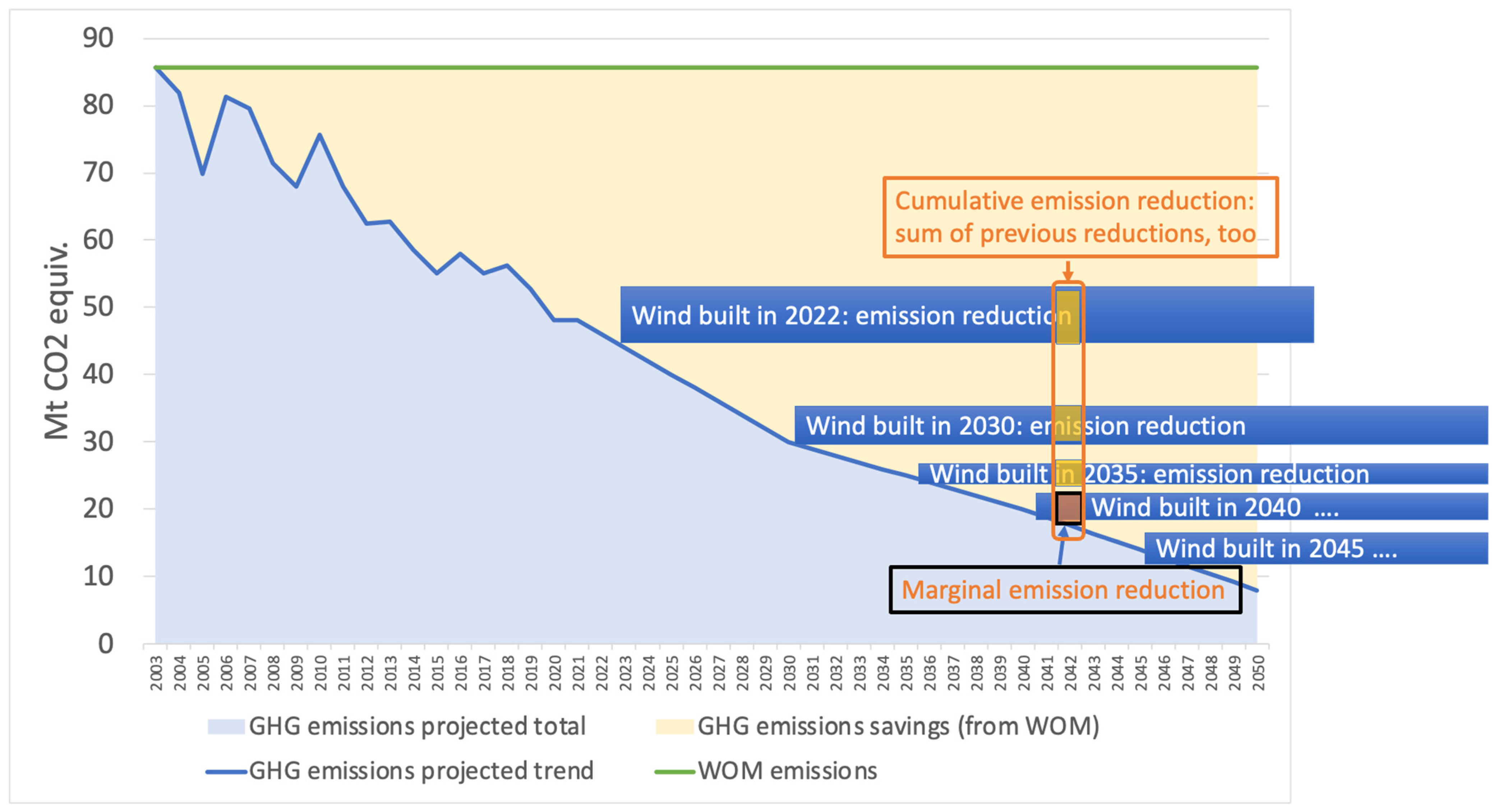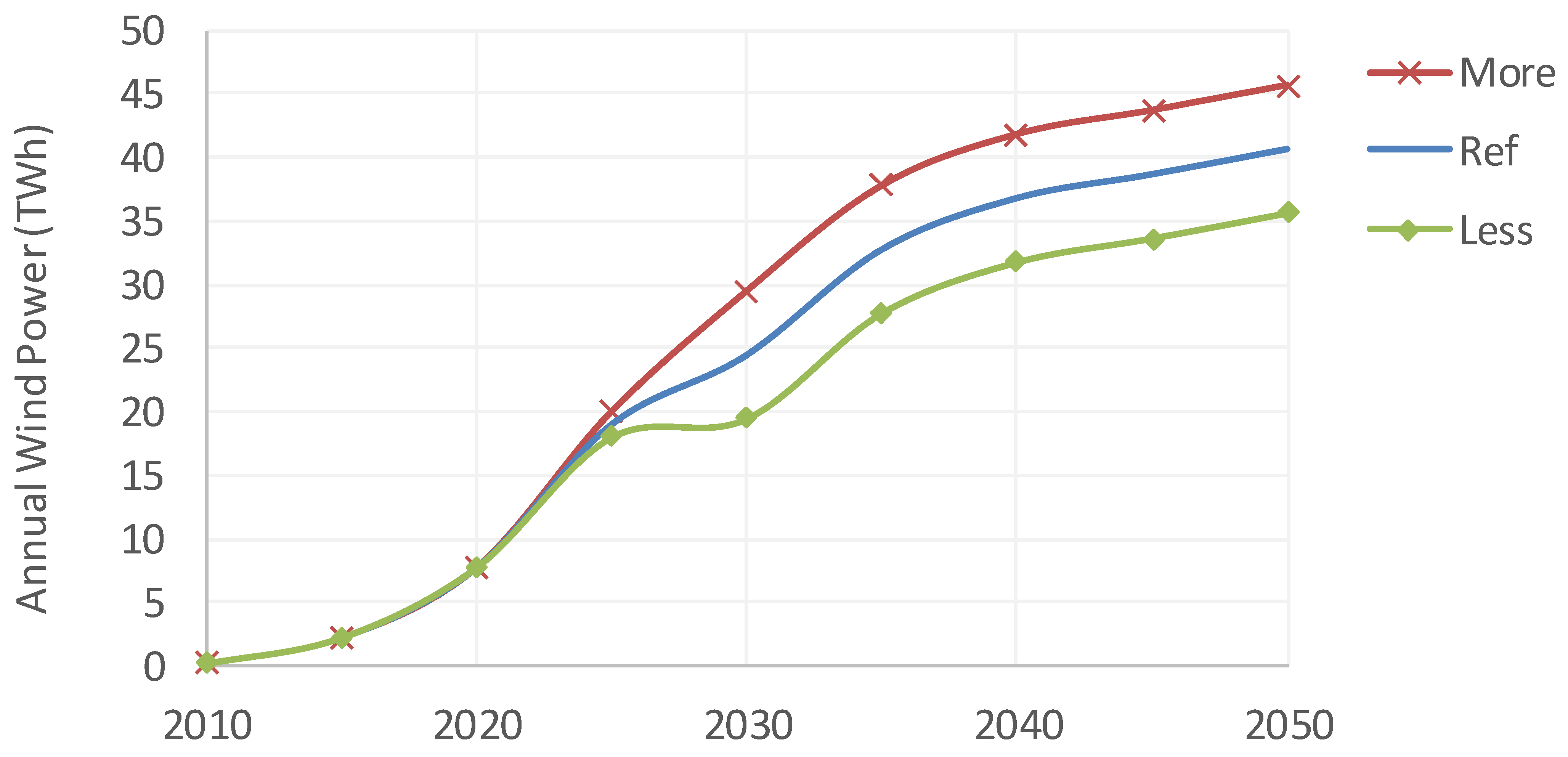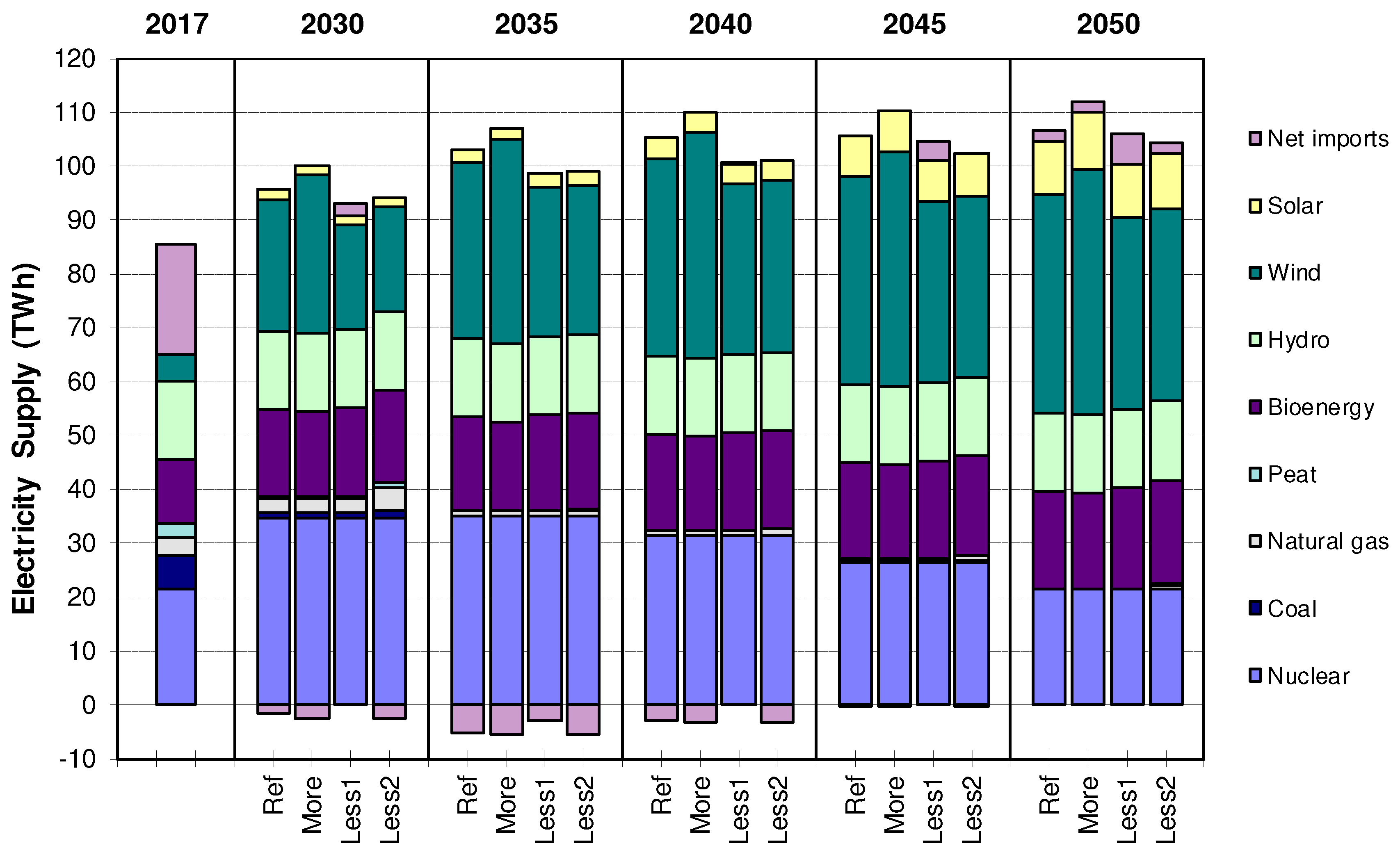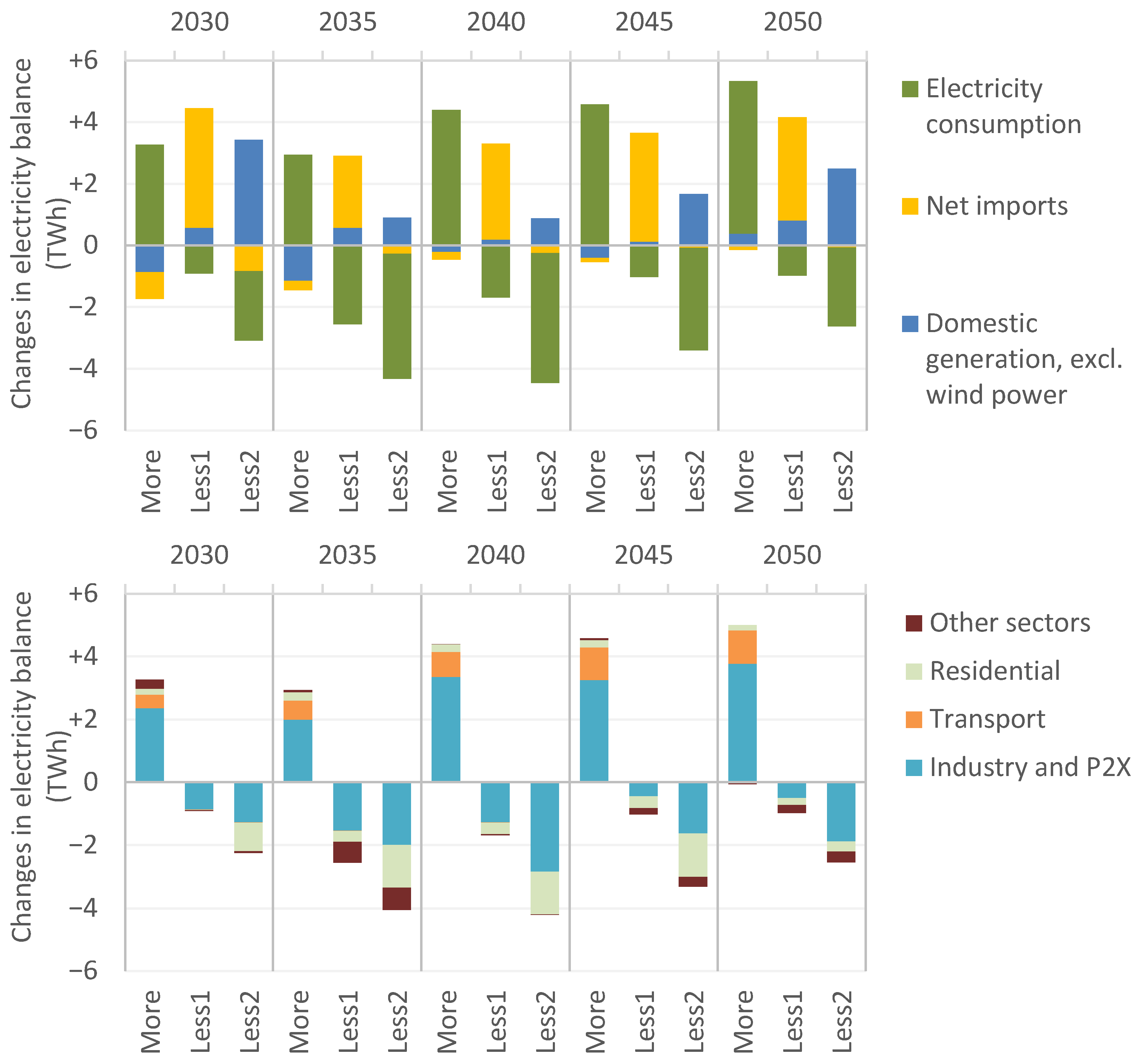Estimating the CO2 Impacts of Wind Energy in the Transition Towards Carbon-Neutral Energy Systems
Abstract
1. Introduction
2. Method Used for Assessing Emission-Reduction Impact
2.1. Requirements for the Modeling Framework
2.2. TIMES-VTT Energy System Model
2.3. Reference Scenario
2.4. Wind Power Scenarios
3. Results from the Case Study: Finland, Years 2030–2050
3.1. Wind Power’s Impacts on the Energy System
3.2. Emission Impacts of Wind Energy
4. Discussion
4.1. Marginal or Cumulative Benefit of Wind Energy?

4.2. Impact of Modeling Approach
5. Conclusions
- →
- Wind-induced CO2 reductions in electricity generation provide a higher impact for 2030–2040 but reduce towards 0 for the period of 2040–2050 (for Finland, this was observed especially when including export possibilities for the rest of Europe, but also for the first years, 2030 and 2035, when limiting exports in the ‘Less’ scenarios).
- →
- Including options for the electrification of all of the energy end-use sectors increases the impact of the emissions reduction achieved using wind energy (for Finland, this was observed when adding wind energy for the years 2045–2050 in the ‘More’ scenario).
- →
Author Contributions
Funding
Data Availability Statement
Conflicts of Interest
References
- Chipindula, J.; Botlaguduru, V.S.; Du, H.; Kommalapati, R.R.; Huque, Z. Life Cycle Environmental Impact of Onshore and Offshore Wind Farms in Texas. Sustainability 2018, 10, 2022. [Google Scholar] [CrossRef]
- Vestas. Life Cycle Assessment of Electricity Production from an Onshore V136-4.2 MW Wind. Plant. Vestas Wind Systems A/S, Denmark. 22 March 2022. 133p. Available online: https://www.vestas.com/content/dam/vestas-com/global/en/sustainability/reports-and-ratings/lcas/LCA%20of%20Electricity%20Production%20from%20an%20onshore%20V136-4.2MW%20Wind%20Plant_Final.pdf.coredownload.inline.pdf (accessed on 20 February 2025).
- Benitez, A.; Wulf, C.; Steubing, B.; Geldermann, J. Scenario-based LCA for assessing the future environmental impacts of wind offshore energy: An exemplary analysis for a 9.5-MW wind turbine in Germany. Energy Sustain. Soc. 2024, 14, 49. [Google Scholar] [CrossRef]
- Kubiszewski, I.; Cleveland, C.J.; Endres, P.K. Meta-analysis of net energy return for wind power systems. Renew. Energy 2010, 35, 218–225. [Google Scholar] [CrossRef]
- Holttinen, H.; Kiviluoma, J.; McCann, J.; Clancy, M.; Milligan, M.; Pineda, I.; Eriksen, P.B.; Orths, A.; Wolfgang, O. Reduction of CO2 emissions due to wind energy—Methods and issues in estimating operational emission reductions. In Proceedings of the 2015 IEEE Power & Energy Society General Meeting, Denver, CO, USA, 26–30 July 2015; pp. 1–5, ISBN 978-1-4673-8040-9. [Google Scholar] [CrossRef]
- Aliprandi, F.; Stoppato, A.; Mirandola, A. Estimating CO2 emissions reduction from renewable energy use in Italy. Renew. Energy 2016, 96, 220–232. [Google Scholar] [CrossRef]
- Anke, C.-P.; Schönheit, D.; Möst, D. Measuring the Impact of Renewable Energy Sources on Power Sector Carbon Emissions in Germany—A Methodological Inquiry. Z. Energiewirtsch. 2021, 45, 1–23. [Google Scholar] [CrossRef]
- Yousefi, H.; Abbaspour, A.; Seraj, H.R. Worldwide Development of Wind Energy and CO2 Emission Reduction. Environ. Energy Econ. Res. 2019, 3, 1–9. [Google Scholar] [CrossRef]
- Lindroos, T.J.; Monni, S.; Honkatukia, J.; Soimakallio, S.; Savolainen, I. Estimations of Greenhouse Reductions and Economical Effects of Renewable Energy in Finland; VTT Technology 11; VTT Technical Research Centre of Finland: Espoo, Finland, 2012; 121p. + app. 6p. [Google Scholar]
- Holttinen, H.; Tuhkanen, S. The effect of wind power on CO2 abatement in the Nordic Countries. Energy Policy 2004, 32, 1639–1652. [Google Scholar] [CrossRef]
- SysFlex D2.5. 2020. Financial Implications of High Levels of Renewables on the European Power System. EU-SysFlex H2020 Project. Available online: https://eu-sysflex.com/documents/ (accessed on 21 February 2025).
- Koljonen, T.; Lehtilä, A.; Honkatukia, J.; Markkanen, J. Pääministeri Sanna Marinin Hallituksen Ilmasto-ja Energiapoliittisten Toimien Vaikutusarviot: Hiilineutraali Suomi 2035 (HIISI)-Jatkoselvitys; VTT Technology No. 402; VTT Technical Research Centre of Finland: Espoo, Finland, 2022. [Google Scholar] [CrossRef]
- Bahramian, P.; Jenkins, G.P.; Milne, F. The Displacement Impacts of Wind Power Electricity Generation: Costly Lessons from Ontario. Energy Policy 2021, 152, 112211. [Google Scholar] [CrossRef]
- Lindroos, T.J.; Mäki, E.; Koponen, K.; Hannula, I.; Kiviluoma, J.; Raitila, J. Replacing fossil fuels with bioenergy in district heating—Comparison of technology options. Energy 2021, 231, 120799. [Google Scholar] [CrossRef]
- Tatarewicz, I.; Lewarski, M.; Skwierz, S.; Krupin, V.; Jeszke, R.; Pyrka, M.; Szczepański, K.; Sekuła, M. The Role of BECCS in Achieving Climate Neutrality in the European Union. Energies 2021, 14, 7842. [Google Scholar] [CrossRef]
- AIGS. All Island Grid Study, Eirgrid and SONI. 2008. Available online: https://cms.eirgrid.ie/sites/default/files/publications/11-AllIslandGridStudyStudyOverviewJan08.pdf (accessed on 20 February 2025).
- Backe, S.; Korpås, M.; Tomasgard, A. Heat and electric vehicle flexibility in the European power system: A case study of Norwegian energy communities. Int. J. Electr. Power Energy Syst. 2021, 125, 106479. [Google Scholar] [CrossRef]
- Haaland, P.K.N.H. Impact of CO2 Compensation Methods on the Sizing of PV Panels in Zero Emission Neighbourhoods. Master’s Thesis, Norwegian University of Science and Technology, Trondheim, Norway, 2022. [Google Scholar]
- Kartha, S.; Lazarus, M.; Bosi, M. Baseline recommendations for greenhouse gas mitigation projects in the electric power sector. Energy Policy 2004, 32, 545–566. [Google Scholar] [CrossRef]
- Loulou, R.; Goldstein, G.; Kanudia, A.; Lehtilä, A.; Remme, U. Documentation for the TIMES Model. 2016. Available online: https://iea-etsap.org/docs/Documentation_for_the_TIMES_Model-Part-I_July-2016.pdf (accessed on 21 February 2025).
- Pursiheimo, E.; Holttinen, H.; Koljonen, T. Path towards 100% renewable energy future and feasibility of power-to-gas technology in Nordic Countries. IET Renew. Power Gener. 2017, 11, 1695–1706. [Google Scholar] [CrossRef]
- Lehtilä, A.; Koljonen, T. Pathways to Post-fossil Economy in a Well Below 2 °C World. In Limiting Global Warming to Well Below 2 °C: Energy System Modelling and Policy Development; Lecture Notes in Energy; Springer: Cham, Switzerland, 2018; pp. 33–49. [Google Scholar] [CrossRef]
- Koljonen, T.; Aakkula, J.; Honkatukia, J.; Soimakallio, S.; Haakana, M.; Hirvelä, H.; Kilpeläinen, H.; Kärkkäinen, L.; Laitila, J.; Lehtilä, A.; et al. Hiilineutraali Suomi 2035: Skenaariot ja Vaikutusarviot; VTT Technology No. 366; VTT Technical Research Centre of Finland: Espoo, Finland, 2020. [Google Scholar] [CrossRef]
- Koljonen, T.; Silfver, T.; Soimakallio, S.; Koreneff, G.; Lehtilä, A.; Markkanen, J.; Vainio, T.; Aakkula, J.; Haakana, M.; Hirvelä, H.; et al. Baseline Scenarios for Energy and Climate Policy Package Towards Zero Emissions; Publications of the Government´s Analysis, Assessment and Research Activities 2024:26; Publisher Prime Minister’s Office: Helsinki, Finland, 2024. Available online: http://urn.fi/URN:ISBN:978-952-383-219-0 (accessed on 20 February 2025).
- Finlex. Finnish Climate Law. 2022. Available online: https://www.finlex.fi/fi/laki/alkup/2022/20220423 (accessed on 21 February 2025). (In Finnish and Swedish only).
- LVM Ministry of Transport and Communications (2022) Fossiilittoman Liikenteen Tiekartta—Valtioneuvoston Periaatepäätös Kotimaan Liikenteen Kasvihuonekaasujen Vähentämisestä. Available online: https://api.hankeikkuna.fi/asiakirjat/d99a3ae3-b7f9-49df-afd2-c8f2efd3dc1d/e4e97efb-1f23-4c22-bdf1-f1fc27809030/LAUSUNTOPYYNTO_20210115060016.PDF (accessed on 21 February 2025).
- Anttila, P.; Nivala, V.; Salminen, O.; Hurskainen, M.; Kärki, J.; Lindroos, T.J.; Asikainen, A. Regional balance of forest chip supply and demand in Finland in 2030. Silva Fennica 2018, 52, 9902. [Google Scholar] [CrossRef]
- Statistics Finland. 14qt—Emission Coefficients for Electricity Generation and Share of Renewable Electricity Generation, 2000–2023. 2024. Available online: https://pxweb2.stat.fi/PxWeb/pxweb/en/StatFin/StatFin__ehk/statfin_ehk_pxt_14qt.px/ (accessed on 21 February 2025).
- Statistics Finland. Emissions in the Energy Sector Continued to Decrease in 2023—The Land Use Sector Was a Significant Source of Emissions. 2025. Available online: https://stat.fi/en/publication/clmpwhj34iw9n0cuntl6ngb08 (accessed on 21 February 2025).
- Fingrid. Investments in the Main Grid Rise to EUR 3 Billion. Available online: https://www.fingrid.fi/en/news/news/2022/investments-in-the-main-grid-rise-to-eur-3-billion/ (accessed on 21 February 2025).
- Liski, J.; Repo, A.; Känkänen, R.; Vanhala, P.; Seppälä, J.; Antikainen, R.; Grönroos, J.; Karvosenoja, N.; Lähtinen, K.; Leskinen, P.; et al. Metsäbiomassan Energiakäytön Ilmastovaikutukset Suomessa. Suomen Ympäristö 5/2011. Available online: http://hdl.handle.net/10138/37051 (accessed on 20 February 2025).
- European Environment Agency. Guidelines for Reporting on Policies and Measures by Member States under Regulation (EU) No 525/2013 (EU Monitoring Mechanism Regulation). 2019. Available online: https://cdr.eionet.europa.eu/help/mmr/MMR%20Article%2013%20Reporting%20Manual%20PaMs%20(2018).pdf (accessed on 21 February 2025).
- Statistics Finland. Energy Supply and Consumption. 2025. Available online: https://www.stat.fi/tilasto/ehk (accessed on 21 February 2025).
- Müller, S.; Holttinen, H.; Taibi, E.; Smith, J.C.; Fraile, D.; Vrana, T.-K. System Integration Costs—A Useful Concept That Is COMPLICATED to Quantify? In Proceedings of the 17th International Workshop on Large-Scale Integration of Wind Power into Power Systems as well as on Transmission Networks for Offshore Wind Power Plants, WIW 2018, Stockholm, Sweden, 17–19 October 2018; Available online: https://iea-wind.org/task25/t25-publications/ (accessed on 20 February 2025).
- SULPU. Suomen Lämpöpumppuyhdistys. 2022. Finnish Heat Pump Statistics 2021. Available online: https://www.sulpu.fi/wp-content/uploads/2022/01/SULPU-lampopumpputilasto-2021-kuvaajat.pdf (accessed on 21 February 2025).
- SULPU. Suomen Lämpöpumppuyhdistys. 2022. Lämpöpumppumyynnissä Hurja 80% Kasvu. Available online: https://www.sulpu.fi/lampopumppumyynnissa-hurja-80-kasvu/ (accessed on 21 February 2025).
- Poncelet, K.; Delarue, E.; Six, D.; Duerinck, J.; D’haeseleer, W. Impact of the level of temporal and operational detail in energy-system planning models. Appl. Energy 2016, 162, 631–643. [Google Scholar] [CrossRef]
- Hirth, L. The market value of variable renewables: The effect of solar wind power variability on their relative price. Energy Econ. 2013, 38, 218–236. [Google Scholar] [CrossRef]
- Waite, M.; Modi, V. Impact of deep wind power penetration on variability at load centers. Appl. Energy 2019, 235, 1048–1060. [Google Scholar] [CrossRef]
- Denny, E.; O’Malley, M. Wind generation, power system operation, and emissions reduction. IEEE Trans. Power Syst. 2006, 21, 341–347. [Google Scholar] [CrossRef]
- Lew, D.; Brinkman, G.; Ibanez, E.; Florita, A.; Heaney, M.; Hodge, B.M.; Hummon, M.; Stark, G.; King, J.; Lefton, S.A.; et al. The Western Wind and Solar Integration Study Phase 2, NREL Tech. Report NREL/TP-5500-55588. 2013. Available online: https://www.nrel.gov/docs/fy13osti/55588.pdf (accessed on 21 February 2025).
- Kaffine, D.T.; McBee, B.J.; Ericson, S.J. Intermittency and CO2 Reductions from Wind Energy. Energy J. 2020, 41, 23–54. [Google Scholar] [CrossRef]






| Electricity generation in Finland | In 2030, the decrease of 5 TWh/a of wind energy affects mainly gas power (+1.5 TWh/a). For the power and district heat sectors in the ‘More’ scenario, the reduction in bioenergy consumption is highest during 2030–2035 (about 2.5 TWh/a in 2030 and 1.5 TWh/a in 2035), with the reduction decreasing to below 1 TWh/a in the later years of 2040–2050. In the ‘Less’ cases, bioenergy use conversely increases in power and district heat generation, the increase being modest in the ‘Less1’ case but more pronounced in the ‘Less2’ case, where the impact is notable (about 2.8 TWh/a) already in 2030. Moreover, while being smaller in 2040–2045, it returns to above 2.8 TWh/a by 2050. |
| Electricity consumption in Finland | The consumption grows in all scenarios by about 10 TWh/a from 2030 to 2050. All years see a considerable impact from wind power for electricity consumption in the end-use sectors and energy transformation (e.g., fuel production). The ‘More’ scenario sees an increase of 3 TWh/a in consumption and an increase of 4.5 TWh/a from 2040 onwards. The ‘Less2’ scenario sees a consumption reduction of 4 TWh/a from 2035 onwards compared with the reference scenario. |
| Impacts through trade | As a sensitivity, the ‘Less1’ scenario allows the model to reoptimize import/export from the reference scenario, and also for yearly amounts of exchange. As expected, reducing wind power by 5 TWh/a required more electricity from neighboring regions. Annual net imports increased by 3.5 TWh/a in the ‘Less1’ scenario, meaning that the generation and consumption of energy outside of Finland was impacted by reduced clean generation in Finland. |
| Fuel production | In the ‘More’ scenario, the model replaces part of the produced bioliquids with e-fuels (hydrogen production) that increase the electricity consumption (+3 TWh/a in 2040) and the electrification of heavy transport. The changes in the e-fuel amounts occurred mostly from 2040 to 2050. The decrease in wood-based bioenergy use was 3–4 TWh/a between 2040 and 2050. The supply of carbon-neutral fuels was thereby electrified more rapidly due to the additional wind power production in the ‘More’ scenario. In the ‘Less’ cases, the impacts on fuel production were not significant compared with the reference, as the lower number of EVs was fixed. |
| Transport sector | In the ‘More’ scenario, plug-in-hybrid vehicles become more competitive when additional wind power reduces prices, and thereby accelerates the electrification of road transport (+0.4 TWh/a in 2030, +0.8 TWh/a in 2040). This will replace fossil fuels, but also biofuels in the later years. However, no converse effect was observed in the ‘Less2’ scenario, which indicates that the elasticity in the penetration of electric vehicles is asymmetrical in this scenario due to user-given constraints on the minimum share of EVs following the projections of current development and likely near-term policies. |
| Industrial final energy | In the ‘More’ scenario, electricity use in industry was mainly observed in industry heat demand, even if it was somewhat affected in many subsectors due to additional electrification of the process of heat production, but also to some extent through decreased investments into more efficient new end-use technologies, due to the price effect. These industry sector impacts appear more or less symmetrical in the ‘Less2’ scenario as well. The direct use of wood fuels for industrial processes remains almost unchanged. |
| Residential sector | In the ‘More’ scenario, electricity demand increases in the residential sector (+0.2 TWh/a in 2030 and 2040), replacing bio-pellets for in-house heating systems. The impact is relatively small as building sector development is driven mainly by other factors than variable energy price, for example, the lifetime of heating equipment and pipes in buildings. The building-sector modeling was found to be somewhat inflexible from the perspective of this kind of study; how quickly changes could be implemented, for example, during the current high prices, should be investigated further. In the ‘Less’ scenarios, there is a converse impact in the residential sector, more notably in the ‘Less2’ case (−1 TWh/a in 2030) in terms of decreased penetration of in-house heat pumps. |
| gCO2eq/kWh | 2030 | 2035 | 2040 | 2045 | 2050 | Average 2030–2050 |
|---|---|---|---|---|---|---|
| More = addition of 5 TWh/a | 120 (+120 = 240) | 90 (+130 = 220) | 80 (+170 = 260) | 320 (+130 = 450) | 270 (+160 = 430) | 180 (+140 = 320) |
| Less 2 = reduction of 5 TWh/a | 400 (+140 = 540) | 280 (+70 = 350) | 150 (+0 = 150) | 140 (+0 = 140) | 30 (+50 = 80) | 230 (+20 = 250) |
| Less 1 = reduction of 5 TWh/a, but allowing increased electricity trade | 560 (+50 = 610) | 380 (+40 = 420) | 190 (+0 = 190) | 50 (+0 = 50) | 20 (+0 = 20) | 240 (+20 = 260) |
| gCO2eq/kWh | More | Less1 | Less2 |
|---|---|---|---|
| Average marginal impact 2030–2050, Fin-Direct + RoEur | −177 | +268 | +232 |
| Average marginal impact 2030–2050, Fin-Direct + RoEur + Fin-LULUCF | −319 | +259 | +254 |
Disclaimer/Publisher’s Note: The statements, opinions and data contained in all publications are solely those of the individual author(s) and contributor(s) and not of MDPI and/or the editor(s). MDPI and/or the editor(s) disclaim responsibility for any injury to people or property resulting from any ideas, methods, instructions or products referred to in the content. |
© 2025 by the authors. Licensee MDPI, Basel, Switzerland. This article is an open access article distributed under the terms and conditions of the Creative Commons Attribution (CC BY) license (https://creativecommons.org/licenses/by/4.0/).
Share and Cite
Holttinen, H.; Lindroos, T.J.; Lehtilä, A.; Koljonen, T.; Kiviluoma, J.; Korpås, M. Estimating the CO2 Impacts of Wind Energy in the Transition Towards Carbon-Neutral Energy Systems. Energies 2025, 18, 1548. https://doi.org/10.3390/en18061548
Holttinen H, Lindroos TJ, Lehtilä A, Koljonen T, Kiviluoma J, Korpås M. Estimating the CO2 Impacts of Wind Energy in the Transition Towards Carbon-Neutral Energy Systems. Energies. 2025; 18(6):1548. https://doi.org/10.3390/en18061548
Chicago/Turabian StyleHolttinen, Hannele, Tomi J. Lindroos, Antti Lehtilä, Tiina Koljonen, Juha Kiviluoma, and Magnus Korpås. 2025. "Estimating the CO2 Impacts of Wind Energy in the Transition Towards Carbon-Neutral Energy Systems" Energies 18, no. 6: 1548. https://doi.org/10.3390/en18061548
APA StyleHolttinen, H., Lindroos, T. J., Lehtilä, A., Koljonen, T., Kiviluoma, J., & Korpås, M. (2025). Estimating the CO2 Impacts of Wind Energy in the Transition Towards Carbon-Neutral Energy Systems. Energies, 18(6), 1548. https://doi.org/10.3390/en18061548






